And the Army Goes Rolling Along – A World War III Team Yankee American – Book Review
By Tom Burgess
I am very excited about the impending release of the new World War III Team Yankee American book. That may surprise many who know me as I have only ever played Soviet and East Block type forces in Team Yankee so far. But the reality is that US forces were my first purchase for Team Yankee and I have quite a collection of US units still boxed and waiting to be built.
I only shifted to Soviets to help the force balance in my local gaming area. By now my Soviets are quite complete and its time for me to go full throttle into Americans for Team Yankee with this new book.
The World War III Team Yankee American book is a significant expansion from the preceding Stripes US Forces in World War III book. All the formations and support that were available to the US player in Stripes are also in the new book. In addition to these, the new book has added the M1A1 Armored Combat Team, M2 Bradley Combat Team, M3 Bradley Cavalry Troop, Combined Army (Heavy) Company, Combined Arms (Light) Company, and the Light Attack Company.
As the new World War III Team Yankee American book is so huge at 109 pages, this review will focus on the formations, units, and equipment, that were not previously covered in Stripes US Forces in World War III.
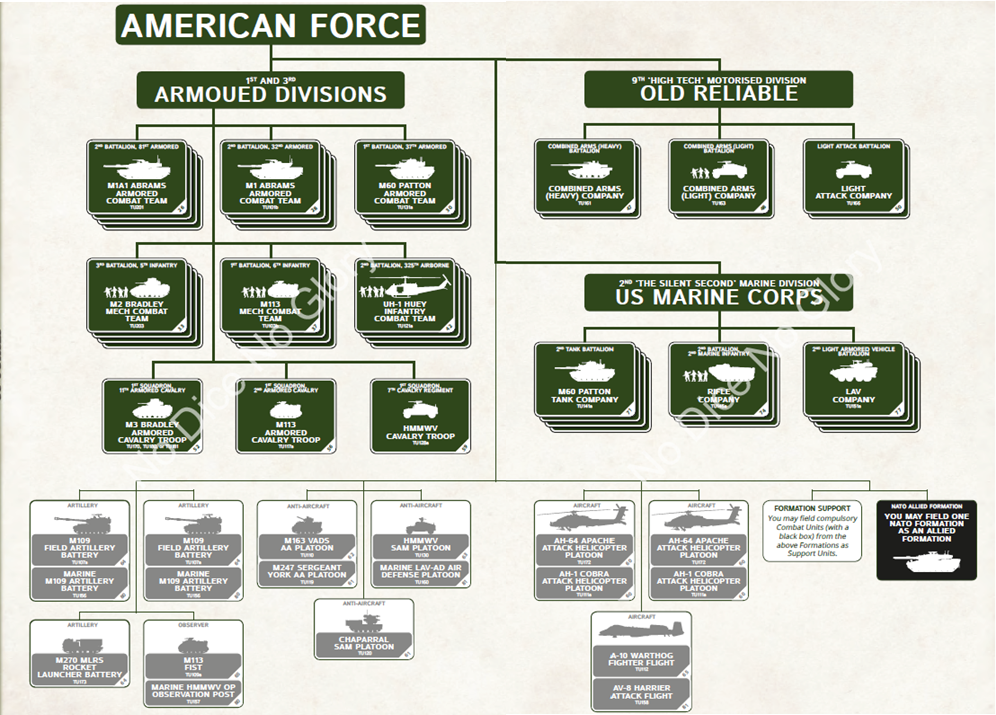 The “Big Five”
The “Big Five”
The World War III Team Yankee American book takes WW3 Team Yankee US forces beyond 1985 and into 1990. This period saw a rapid rearming and reorganization of the US army. The centerpieces for his rapid US Army improvement program were the “Big Five” which included M1 Abrams, M2 Bradley, Patriot missile, Black Hawk and Apache. The World War III Team Yankee American book now gives us three of these five.
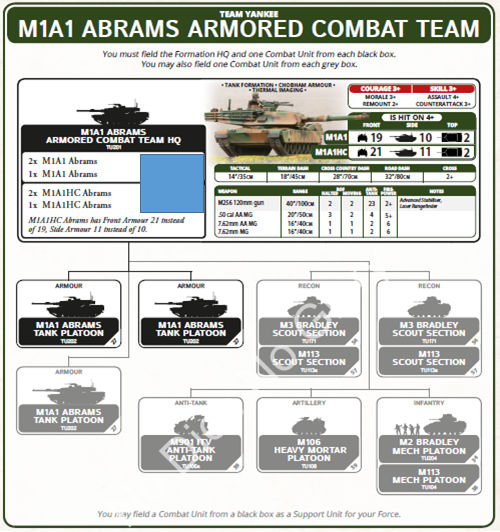 Perhaps the most awaited addition to the new book was the “big guns.” We are talking about the 120mm armed M1A1 and M1A1HC “Heavy Common” tanks. These beast are impressive and are now the absolute best tank in WW3 Team Yankee. But that domination comes at a steep price. The M1A1s are 14 points each while the M1A1HCs are a whopping 18 points each.
Perhaps the most awaited addition to the new book was the “big guns.” We are talking about the 120mm armed M1A1 and M1A1HC “Heavy Common” tanks. These beast are impressive and are now the absolute best tank in WW3 Team Yankee. But that domination comes at a steep price. The M1A1s are 14 points each while the M1A1HCs are a whopping 18 points each.

You cannot deny their stats, but at these prices, MA1A1 and M1A1HC use may be limited to a single platoon supporting a lighter cheaper formation. Think King Tigers in WW2 supporting German Grenadiers. In fact, taking a full platoon of M1A1HCs will cost far more than the minimum 40% of a 100 point force. This means if you have reserves in your mission, this beast will have to go in to reserve leaving a much smaller force trying to hang on until the tanks roll in.
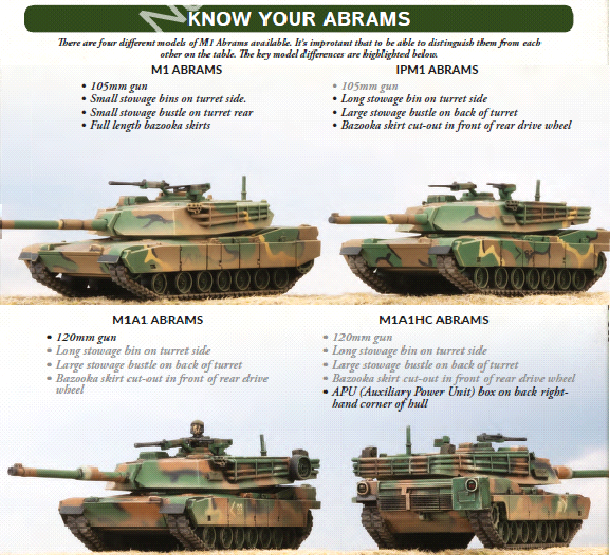
Battlefront is now providing the US player four variants of the M1 Abrams tank. In order to help describe the differences in these, they have included the “Know Your Abrams” photos of these variants.
The main way Battlefront suggest we distinguish between the M1A1s and M1A1HCs is the addition of the Auxiliary Power Units (APU) hanging off the right rear of the tank. This is convenient but the reality is when APUs came out, they were equipped to the IPM1s and the M1A1s as well as the M1A1HCs. So you could add APUs to any of these. The straight M1s would never have had them. By the time the APUs came out, the older M1s were already being refitted as M1A1s.
The APUs were very important. They allowed the tank to be completely powered while stationary without having to run the gas-guzzling turbine. The turbines burned nearly as much fuel while idling as they did driving at full speed.

The next of the “Big Five” that the World War III Team Yankee American books gives us is the M2 and M3 Bradley. Players have been clamoring for these since the original release of Team Yankee. Battlefront has given us four variants, the M2 and M2A2 Infantry Fighting Vehicle (IFV) and the M3 and M2A2 Cavalry Fighting Vehicle (CFV). The M2A2 and M3A3 versions were unarmored from the original M2 and M3.
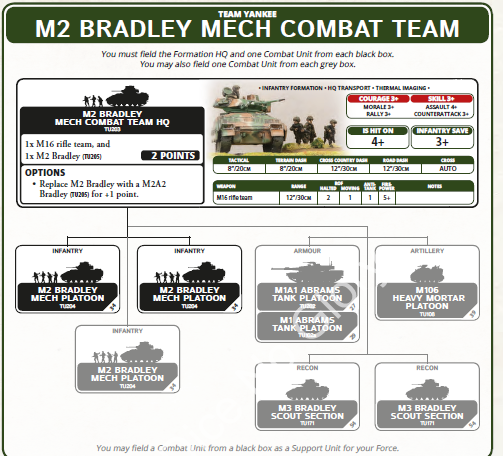
The M2 IFV and the M3 CFV are functionally almost the same vehicle stats wise. The M3 though gave up much of the troop compartment to make room for more TOW Missiles and 25mm ammo. The M3 actually only had room for two scouts that could dismount. In game terms, the M3 and M3A2 give up Transport but gain Scout and Spearhead.
Both the M2 IFV and M3 CFV are rated as Amphibious. Yes, they were designed to be amphibious but in reality, they were unstable and dangerous when swimming. You really should not use the amphibious rule. This is especially true for the M2A2 and M3A2 which had the swimming trim vanes removed.
You might have noticed that instead of the TOW missiles from Stripes. The M2s and M3s have the TOW-2. The TOW-2 ups the anti-tank value up to AT 23 from the TOW’s original AT 21. World War III Team Yankee American also allows other TOW systems to upgrade to the TOW-2 or keep the original, but the M2/M2A2 and M3/M3A2 can only take the TOW-2.
The M3 Bradley Armored Cavalry Troop is a new formation added in World War III Team Yankee American. This formation has a lot of available core units. However, one thing that it gets wrong is that in the Troop HQ you can only take a single M1 Abrams or M3 Bradley. The Armored Cavalry Troop HQ should have the option to take both. The Troop Commanding Officer (CO) would ride in an M1 Abrams, while the Troop Executive Officer (XO) would ride in M3 Bradley.
In the M3 Bradley Armored Cavalry Troop, M3 units are only fielded in sections of two M3 CFVs instead of a platoon of six CFVs. This is doctrinally correct for reconnaissance and screening missions, but if the troop ever had to attack or defend, the sections would likely form back up into platoons of six CFVs. My chief concern here is that with just two M3s in a section, the loss of one means that section immediately goes into Poor Spirits. I worry that this may dissuade many from running the M3 Bradley Armored Cavalry Troop.
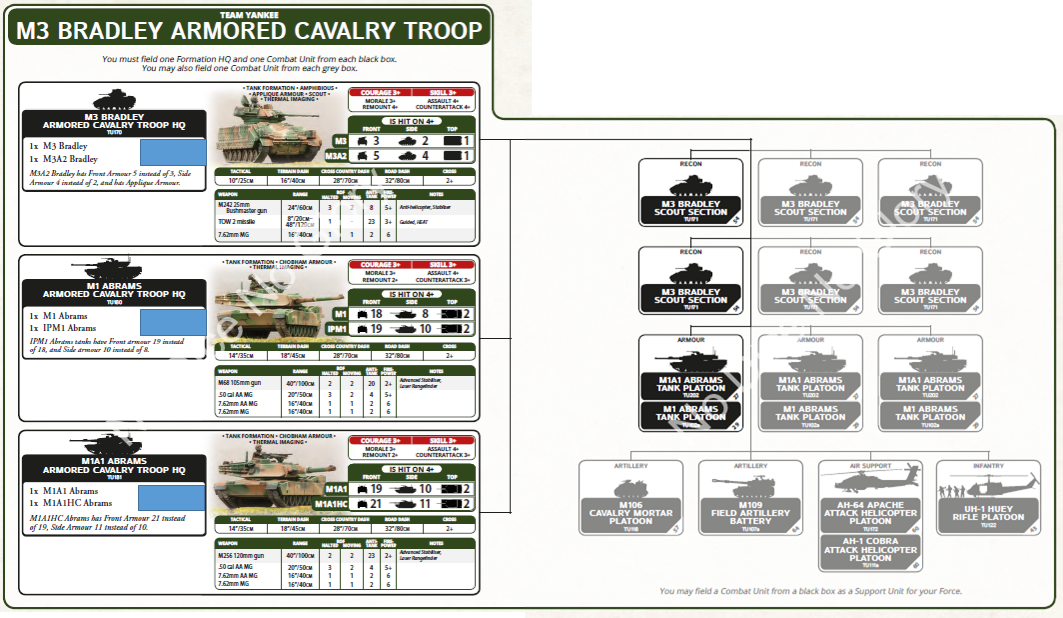

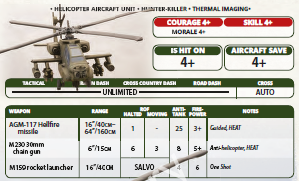 The next of the “Big Five” that we get in the World War III Team Yankee American book is the AH-64 Apache Attack Helicopter. These come in at six points apiece. The Hellfire missiles that the AH-64 Apache is equipped with are incredible with AT 25 and a 64″ range.
The next of the “Big Five” that we get in the World War III Team Yankee American book is the AH-64 Apache Attack Helicopter. These come in at six points apiece. The Hellfire missiles that the AH-64 Apache is equipped with are incredible with AT 25 and a 64″ range.
I was a bit surprised that the Rate of Fire stayed at just one. The AH-64 could carry 16 laser designate Hellfire missiles. A good AH-64 gunner would have several missiles staggered in the air at once so after one missile hit home, the next was already halfway to the next target. This is similar to how the M109’s Copperhead laser-guided artillery rounds and the Soviet 2S3 Acacia’s Krasnopol laser-guided artillery rounds which are fired in rapid succession and guided in by a single forward observer equipped with a laser designator.
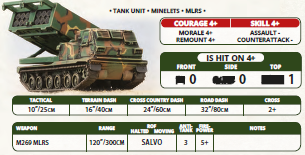 One new piece of kit that should have been in the “Big Five” but somehow did not make it is the M270 Multiple Rocket Launcher (MRLS). The British have had these in the rules for quite a while but they have finally caught up in the US arsenal now. These are three points apiece, like their counterparts in the British army and they have the same minelet ammunition option.
One new piece of kit that should have been in the “Big Five” but somehow did not make it is the M270 Multiple Rocket Launcher (MRLS). The British have had these in the rules for quite a while but they have finally caught up in the US arsenal now. These are three points apiece, like their counterparts in the British army and they have the same minelet ammunition option.
What we have covered thus far in this article adds all one needs to complete historical US forces for 1985 to 1990 time frame. Now let’s get a little ahistorical.
Light and Lethal
Battlefront has not shied away from including hypothetical/experimental equipment, like the M247 Sergeant York, into Team Yankee. But in this book, we are getting full experimental formations and even more experimental equipment. Accordingly, World War III Team Yankee American adds three formations as part of the 9th Infantry Division (Motorized). This division was stationed at Ft Lewis Washington with two light infantry brigades that rode to battle on Fast Attack Vehicles (basically dune buggies) that were eventually replaced with more reliable and safer HUMMWVs.
The 9th Infantry Division (Motorized) was a unique experimental division that did exist in the 80’s US Army. It was meant to be part of a rapid response force that could deploy almost anywhere in the world very quickly. So all if its equipment was very light. To represent the Infantry Division (Motorized) World War III Team Yankee American adds three formations; the Combines Army (Heavy) Company, the Combined Army (Light) Company, and the Light Attack Company.
Cursorily the 9th Infantry Division (Motorized) units have have base a skill rating of 3+ (2+ for commanders). I suppose Battlefront feels that as an “experimental” command the 9th should be better trained. I’m not sure I want to disagree with that, but I definitely don’t think that the 9th should have this upgrade when the elite 82nd Airborne and Cavalry units do not.
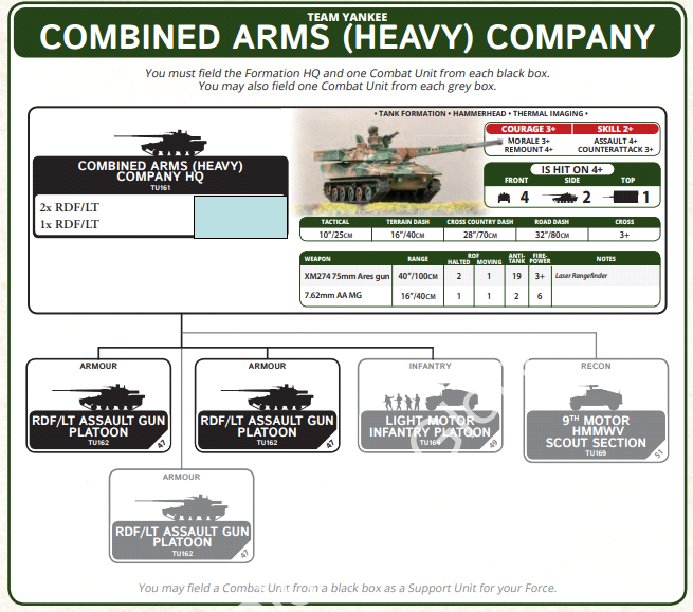
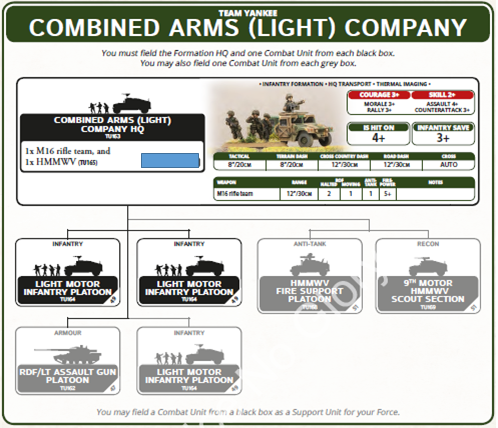
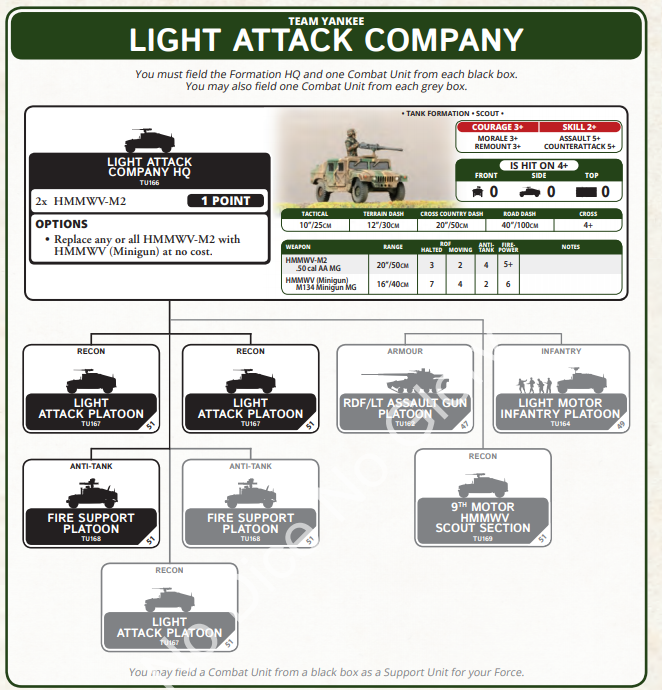
What will immediately catch everyone’s attention in this 9th Infantry Division (Motorized) formations is the RDF/LT Assault Gun. This very experimental platform gives the US a very cheap “tank.” Though it lacks armor, the RDF/LT Assault Gun can be very survivable due to it having the Hammerhead special rule. The idea was that the gun of the RDF/LT Assault Gun would elevate well above the hull allowing the vehicle to stay Concealed and Gone to Ground while firing. The gun is ROF 2 when stationary and 1 moving with an AT of 19 and firepower of 3+. At just two points apiece, the RDF/LT Assault Gun, when on defensive, is an excellent counter to swarms of BMPs.
The Light Motor Infantry Platoon is just 10 points for ten HUMMWVs armed with a 7.62 MG, six SAW/M72 teams, one M60 GPMG team, and the M47 Dragon teams. This is a decent multi-purpose force at a low cost. The HUMMWV Light Attack Platoon at 2 points has four HUMMWVs that carry no troops but are up-gunned with two M2s .50 cal MGs, an MK19s Grenade Launcher and a Minigun. The HUMMWV Fire Support Platoon has two or four TOW armed HUMMWVs at about 1.5 points each. Like all regular TOWs in World War III Team Yankee American, they can be upgraded to the TOW-2.
All of the 9th Infantry Division (Motorized) formations lack any sort of formation fire support. However, they are cheap enough and versatile enough that they make a perfect second, or third formation in a US force. If I were to build 9th Infantry Division (Motorized) force, I think I’d have the Light Motor Infantry Platoons in HUMMWVs but then I’d like to replace the HUMMVs in the HUMMWV Light Attack Platoon, HUMMWV Fire Support Platoon 9th Motor HUMMWV Scout sections with similarly armed Fast Attack Vehicles. Dune buggies for the win!
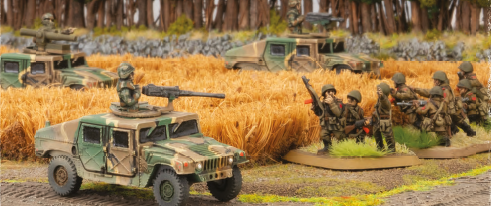 What about the Marines?
What about the Marines?
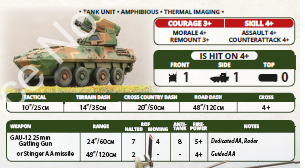 All the Marine formations, units, and equipment that were present in Stripes are back in the new book. The only new things the USMC formations get in is the LAV-AD and the TOW-2 option. The LAV-AD gives another AA support option with Stinger missiles and a 25mm Gatling Gun to the Marines at basically 2 points per vehicle.
All the Marine formations, units, and equipment that were present in Stripes are back in the new book. The only new things the USMC formations get in is the LAV-AD and the TOW-2 option. The LAV-AD gives another AA support option with Stinger missiles and a 25mm Gatling Gun to the Marines at basically 2 points per vehicle.
The TOW-2 upgrade is a great buy. Normally it only costs just a single point to upgrade the unit. However as with the Army units, if you take any TOW-2 in your force you cannot take normal TOWs. All must be upgraded or none.

So there you have it. The World War III Team Yankee American is going to add quite a bit to the WW3 Team Yankee world. I am definitely motivated to start working on my US models I have now and to be ready to add to them as soon as the new models arrive. Battlefront staff had mentioned on one of their Twitch TV sessions that they are trying to produce the new US Infantry for WW3 Team Yankee in there new Thermoplastic material. I hope they succeed with that and that we can buy the Auxiliary Power Units (APU) separately. I want to fit them to the M1 Abrams models I bought years ago. If you are interested in some ideas on how to build your force using this new book, check out Chris Jackson’s


Tom: Great article, looks like I’ll be doing some adds to my current US force.
Thanks Ron, I’m excited to get started on mine.